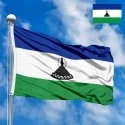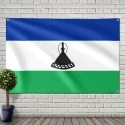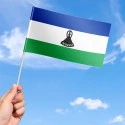The national flag of the Kingdom of Lesotho is a vibrant and deeply symbolic emblem, representing the nation's peaceful and independent spirit, its rich heritage, and its aspiration for prosperity. Adopted on October 4, 2006, to commemorate 40 years of independence, the current flag is the third in Lesotho's history, consciously designed to reflect a renewed sense of national unity, stability, and a future free from internal conflict. Its simple yet powerful imagery resonates with the Basotho people and their commitment to peace.
Design and Symbolism: A Harmonious Blend of Peace and Prosperity
The flag of Lesotho features three horizontal stripes of blue, white, and green, with a distinctive black Basotho hat (mokorotlo) centrally placed on the white stripe. Each color and the central emblem carry significant meaning:
-
Blue (Top Stripe): The uppermost blue stripe symbolizes sky and rain. For Lesotho, a mountainous and largely arid country, rain is vital for life and agriculture, representing prosperity, the heavens, and the bounty of nature. It also evokes the idea of a stable and peaceful sky overhead, reflecting the nation's desire for tranquility and harmony.
-
White (Middle Stripe): The central white stripe is the widest of the three and is the most prominent feature of the flag. This color unequivocally represents peace. Peace is a core tenet of Basotho culture and a fundamental aspiration for a nation that has experienced periods of political instability. The centrality of white emphasizes its paramount importance to the national identity and future.
-
Green (Bottom Stripe): The lowermost green stripe symbolizes prosperity and the land. It represents Lesotho's agricultural wealth, the fertile fields, and the hope for a thriving economy. It also speaks to the nation's connection to its natural environment and the potential for sustainable development.
-
Black Basotho Hat (Mokorotlo) on White Stripe: Centrally placed within the white stripe, the distinctive black Basotho hat (mokorotlo) is the unique and most iconic symbol of Lesotho.
-
The mokorotlo is a traditional conical hat made from local straw, deeply ingrained in Basotho culture. It is worn by both men and women on various occasions and is a symbol of the Basotho people's identity, heritage, and unity.
-
Its black color in the flag symbolizes the black people of Lesotho.
-
The placement of the mokorotlo on the white stripe signifies that peace (white) is central to the Basotho people's (black mokorotlo) identity and their future, achieved under the sky (blue) for the prosperity (green) of their land. It subtly suggests that the peace and stability of the nation are inextricably linked to its people and their cultural heritage.
The overall design creates a balanced and meaningful representation of Lesotho's natural environment, its people, and its core national values.
Dimensions and Proportions:
The official proportions of the Flag of Lesotho are a width-to-length ratio of 2:3. This is a common ratio for many national flags. The three horizontal stripes are not of equal width: the blue stripe occupies 1/3 of the flag's height, the white stripe occupies 1/3, and the green stripe occupies 1/3. The mokorotlo is centrally placed within the white stripe, its height being proportional to 9/10 of the height of the white stripe. This meticulous detailing ensures the balance and prominence of each symbolic element.
History and Evolution: A Journey Towards Lasting Peace
The current flag of Lesotho is the result of a deliberate evolution, reflecting significant shifts in the nation's political landscape and its aspirations.
-
First Flag (1966-1987): When Basutoland gained independence from the United Kingdom on October 4, 1966, and became the Kingdom of Lesotho, it adopted its first national flag. This flag featured vertical green, white, and red stripes, with a white mokorotlo in the center. The colors symbolized the land (green), peace (white), and courage (red).
-
Second Flag (1987-2006): In 1987, after a military coup, a new flag was introduced. This flag featured a diagonal design with white, blue, and green bands, and a traditional Basotho shield, spear, and knobkerrie (club) in the upper hoist corner. The white represented peace, blue represented rain, and green represented prosperity. The shield and weapons symbolized the nation's capacity to defend itself. This flag was, however, associated with the military regime and did not achieve widespread public affection. Its design was seen by some as too aggressive, and it was created without broad national consensus.
-
Third and Current Flag (2006-Present): Recognizing the need for a truly unifying symbol that reflected a new era of political stability and reconciliation, a new flag was proposed and adopted. This current flag was chosen through a public competition and officially adopted on October 4, 2006, marking the 40th anniversary of Lesotho's independence. The design was selected for its emphasis on peace and the inclusion of the mokorotlo, a universally recognized and beloved symbol of Basotho identity, replacing the more militaristic symbols of the previous flag. The shift to horizontal stripes and the reintroduction of the mokorotlo were intended to foster a sense of harmony and national pride, moving away from past divisions and towards a future of unity.
The adoption of the current flag was a conscious effort to establish a national symbol that genuinely represents all Basotho people and their shared aspirations for a peaceful and prosperous future.
Regional Context and Southern African Identity:
Lesotho is a unique country in Southern Africa, being a landlocked enclave completely surrounded by South Africa. Its geographical position heavily influences its regional identity. While culturally distinct, it shares many historical and economic ties with its larger neighbor.
The flag of Lesotho stands out in the Southern African region. Many flags in the region, particularly those that gained independence later in the 20th century, often incorporate elements of Pan-African colors (red, yellow, green, black) and symbols of liberation struggles. Lesotho's current flag, however, emphasizes peace, its natural resources (rain, land), and its unique cultural identity (mokorotlo), rather than a militaristic or revolutionary past. This focus on peace and cultural heritage sets it apart, reflecting Lesotho's aspiration to be a stable and non-confrontational nation in the region, despite its historical challenges. Its distinctiveness reinforces Lesotho's sovereignty and its unique cultural heritage within the Southern African landscape.
Interesting Facts:
-
"Kingdom in the Sky": Lesotho is often called the "Kingdom in the Sky" due to its mountainous terrain and high altitude, a characteristic reflected in the blue stripe (sky) on its flag.
-
Enclaved Country: It is one of only three sovereign states in the world (along with Vatican City and San Marino) that is completely surrounded by another country (South Africa).
-
Third Flag in 40 Years: The current flag is the third national flag adopted by Lesotho since its independence in 1966, reflecting significant political transitions.
-
Designed for Peace: The primary motivation for the 2006 flag change was to create a symbol that emphasized peace and reconciliation after periods of political instability. The previous flag, with its shield and weapons, was seen by some as too militaristic.
-
Mokorotlo Symbolism: The black Basotho hat (mokorotlo) on the flag is a universally recognized cultural symbol of the Basotho people, signifying their unique identity and unity. It's a rare example of a specific item of traditional dress appearing on a national flag.
-
Anniversary Adoption: The current flag was adopted on October 4, 2006, precisely 40 years after Lesotho gained independence, marking a significant milestone.
-
Unique Colors: While blue, white, and green are common flag colors, their specific arrangement and the inclusion of the mokorotlo make Lesotho's flag highly distinctive.
-
No Pan-African Colors: Unlike many other African nations, Lesotho's current flag does not use the traditional Pan-African colors (red, yellow, green), instead opting for a color scheme that reflects its specific national aspirations for peace, rain, and land.
-
Public Contest: The design for the current flag was reportedly chosen through a public competition, indicating a desire for broader national participation in its symbolism.
Significance for the Inhabitants: A Banner of Identity, Unity, and Enduring Peace
For the Basotho people, their national flag is a source of immense pride and a powerful reaffirmation of their unique identity and their collective aspirations. The adoption of the current flag in 2006 was not merely a change of design; it was a deliberate act of national healing and a symbolic commitment to a future defined by peace and unity, rather than past divisions.
The blue stripe, representing the sky and the life-giving rain, resonates deeply with the agricultural heritage of the Basotho people, for whom water is precious. It evokes hope for abundance and the divine blessings that sustain their lives and livelihoods. The central and most prominent white stripe, symbolizing peace, is profoundly meaningful for a nation that has experienced its share of internal strife. It serves as a constant reminder of the paramount importance of reconciliation, dialogue, and harmony within their society. This emphasis on peace is a core value that the Basotho people cherish and strive to uphold in all aspects of their lives.
The green stripe, representing the land and prosperity, speaks to the Basotho's deep connection to their mountainous homeland and their hopes for economic development and a thriving future. It signifies their aspirations for a self-sufficient and prosperous nation, built on the foundations of their natural resources.
However, it is the black mokorotlo on the white stripe that truly makes the flag distinctively Basotho. This traditional hat is a powerful emblem of their cultural heritage, their resilience, and their unity as a people. Its presence on the flag signifies that the Basotho identity itself is intertwined with the pursuit of peace. For many, it reinforces the idea that their cultural values are the bedrock of national stability.
The flag is displayed with reverence during national holidays, traditional ceremonies, and in everyday life. It is a unifying symbol that transcends political affiliations, reminding all Basotho of their shared heritage and their collective responsibility to build a peaceful and prosperous future. It embodies their spirit of self-determination, their commitment to traditional values, and their unwavering hope for a harmonious nation. The flag is a silent yet eloquent promise of a Lesotho that cherishes peace above all else.
In the demonstration images, full-size flags are shown with proportions of 2:3, and hand-held flags with proportions of 1:2.








 Waving flag
Waving flag
 Sizes:
Sizes:
 Round flag
Round flag
 Sizes:
Sizes:
 Rectangular flag 2:3
Rectangular flag 2:3
 Sizes:
Sizes: